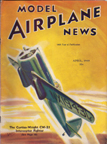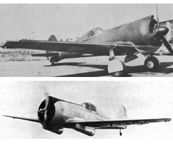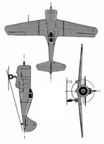April, 1939

Curtiss-Wright CW-2 1"Demon"
Model Airplane News Cover Art for April, 1939
by Jo Kotula
Click to Enlarge
The Curtiss-Wright Model 21 was a United States-built interceptor fighter aircraft, developed by the St. Louis Airplane Division of Curtiss-Wright Corporation during the 1930s.



Photos of the Curtiss-Wright CW-2 1"Demon"
Carl Scott Cowling Patent No. 2,178,998
Click to Enlarge
The CW-21 was not commissioned by the U.S. military, though it was test flown at Wright Field in Dayton, Ohio. The Army Air Corps immediately rejected the aircraft, with one officer commenting that it took a genius to land it. Instead it was developed for export sales by the St. Louis Airplane Division of Curtiss-Wright. The aircraft was a single seat, all-metal cantilever low-wing monoplane with rearward retracting landing gear. The Model 21 was designed by George A. Page, Jr. based on Carl W. Scott's design of the two seater Model 19. The prototype first flew in January 1939. The prototype was designed to carry various combinations of machine guns guns, mounted in the nose and synchronized to fire through the propeller.
The first sale of the CW-21 Demon in 1939, was to the Chinese Air Force, which received three completed examples and kits for 32 more. Assembly would be undertaken by the Central Aircraft Manufacturing Company (CAMCO) located in Loiwing on the China-Burma border. In 1940, The Netherlands ordered 24 examples of a modified version designated the CW-21B (together with a number of two-seat CW-22), for the Royal Netherlands East Indies Army Military Aviation. The modifications consisted of inward retracting landing gear, a semi-retractable tail wheel, and more guns Deliveries started in June 1940, but only 17 had been received , when war with Japan began on 8 December 1941. With its rudimentary pilot protection, lack of self-sealing fuel tanks and light construction, the CW-21B was not unlike the opposing Japanese planes. It had similar firepower to the Nakajima Ki-43 "Oscar", but worse than the cannon-armed A6M Zero. Its climb rate was far better than either. Squadron VLG IV claimed four aerial victories during the Netherlands East Indies campaign but the ML-KNIL was overwhelmed by the sheer number of Japanese adversaries, and all were soon lost in combat or destroyed on the ground.
Click Here for more information about the Curtiss-Wright CW-2 1"Demon".

Click to go back and select another cover.
Counter for the Entire Site (not just this page..)
Home | About Lindy | Last Week's Reviews | Upcoming Events | 1940s Collecibles
The Guide - Establishments - Travel - Accessories
Music | Links | Photo Gallery | Extras | Contact